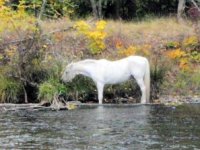C
chuckyblack09
Member
- Joined
- Oct 12, 2016
- Messages
- 48
I have the brookie thing down in freestone streams. I stay relatively stealthy and use really any food item.
My question is more directed toward freestone brown trout and bigger freestone streams. I try to stay stealthy just as I would with brook trout, but I just can't seem to catch browns in freestone streams, even ones with Class A populations of browns.
I seem to get overwhelmed with bigger freestone streams and usually notice a confidence drop while fishing them. I usually don't have confidence using nymphs on bigger water so I end up using a small streamer.
What are some go-to nymph patterns for freestone streams when fishing for browns? I know it's hard to say because freestone streams have a bigger variety of insects, but less of each type. How should I approach bigger water? Where do brown trout usually hold in freestone streams? Same places as brookies?
Any tips and/or experiences you guys can share would be greatly appreciated!
P.S. I understand browns are a lot smarter and pickier with eating, but by now I feel like I should have caught at least one freestone brownie.
My question is more directed toward freestone brown trout and bigger freestone streams. I try to stay stealthy just as I would with brook trout, but I just can't seem to catch browns in freestone streams, even ones with Class A populations of browns.
I seem to get overwhelmed with bigger freestone streams and usually notice a confidence drop while fishing them. I usually don't have confidence using nymphs on bigger water so I end up using a small streamer.
What are some go-to nymph patterns for freestone streams when fishing for browns? I know it's hard to say because freestone streams have a bigger variety of insects, but less of each type. How should I approach bigger water? Where do brown trout usually hold in freestone streams? Same places as brookies?
Any tips and/or experiences you guys can share would be greatly appreciated!
P.S. I understand browns are a lot smarter and pickier with eating, but by now I feel like I should have caught at least one freestone brownie.




